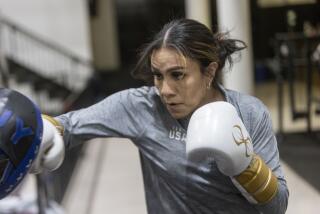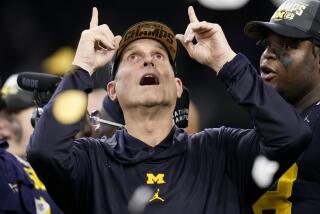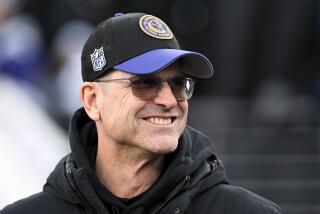Burning Desire Was Dying for Hagler Until Sugar Ray Resurfaced
- Share via
PALM SPRINGS — It took Marvelous Marvin Hagler 49 fights -- in such places as Taunton and New Bedford, Mass., and Portland, Maine -- before he got his crack at the middleweight title. Like prospectors of the last century, Marvin Hagler made it across America on grit. The way stations of the fight game were his endless prairie, his mountains slippery and steep.
Even as he finally panned his hard-won gold, he could never rest. As middleweight champion, Hagler fought off a dozen claim-jumpers who would have taken his crown. At last, when he thought of lighting a campfire, at which he could contemplate his brutal but beautiful feats and convey them to his children, a figure popped onto Hagler’s horizon.
Sugar Ray Leonard had appeared before, but always he had receded. Twice he retired. Notices that he would return proved false. Now, Hagler nudged his confidants, Pat and Goody Petronelli, who had been on the journey with him for 17 years. Could Leonard be for real?
“Goody didn’t believe it,” said Pat Petronelli. “Marvin didn’t believe it, either. I said, ‘Geez, I don’t know, Goody.’ He says, ‘Yeah, I’ll believe it when I see it.’ ”
Once he believed, Hagler struggled to know what to do: to enjoy his riches and let Leonard go, or trade the pain for an $11.75 million guarantee, his biggest strike.
“We said, ‘Whatever you want to do, Marvin,’ ” said Pat Petronelli, Hagler’s manager. “That’s always been our approach, because he’s gone as far as we thought most fighters could go.
“But we knew he was considering it, and we thought the Leonard fight would keep him in there. We felt that way right along; I did.”
Hagler asked Bertha Hagler, “Mrs. Marvelous.”
“She said, ‘I want you home with the family, the kids. We’re wealthy enough,’ ” Pat Petronelli related. Hagler has five children and a life he loves; he owns a sporting-goods store in Hanover, Mass., where he lives, and a New Hampshire retreat. She thought he had fought enough; he worried she might be right. “That’s why he couldn’t make up his mind, he couldn’t say yes or no.
“But she’s the one who swung it. She was the deciding vote. She knew he really wanted to fight Leonard, deep down in his heart he always wanted to fight Leonard.”
Having accepted Leonard’s challenge, Hagler has come back to the desert for a fifth time to the Americana Canyon Hotel, whose luxuries he ignores -- the tennis, the golf, the feeding of charbroiled burgers at the grill beneath his window, the flowers and the fauna. Instead, for his April 6 date with Leonard in Las Vegas, Hagler punishes himself in what he sees as a lonely campsite and personal prison.
“I hope it’s the easiest fight that’s possible,” said Hagler, with unmistakable weariness -- not the “very ugly” mood, as Pat Petronelli put it, that his fighter assumes in the last weeks of training. Hagler had come out for a rare conversation under the desert sun, his training preference being isolation.
“Before this fight, I was seriously thinking of retirement. I felt as though I had beaten everybody out there. I needed more time to put things together. I was talking with my wife and my mother and my grandmother. I knew the way they felt. I also knew that I had accomplished everything that I thought I could do in boxing. And I thought I wanted to go out on top, and this was the right time. So there was a lot of confusion going on inside my head.
“I felt as though Leonard should have fought a guy like (John) Mugabi or a rematch with Thomas Hearns or a Donald Curry, try to get back his undisputed welterweight title before I gave him the opportunity. But I listened and I watched and saw how the press was really picking up on this fight.
“I don’t want it said that I left the game of boxing and didn’t give him the opportunity. And I think that’s exactly what would have happened.”
Goaded, Hagler has ventured forth one more time to scratch for a payday beyond most men’s dreams, even his.
A survivor, Hagler dropped out of high school in Newark, N.J. “I had a kid,” he said, “I had a baby. And I had to quit school so that I could go to work. And I worked at this factory (a toy factory) in Elizabeth, N.J., so I could support my kid. I was a baby myself. I was 16.”
Shortly after the late-’60s race riots in Newark, Mae Hagler took her seven children, Marvin being the oldest, to join relatives in Brockton, Mass. Marvin found his way back to the street, only to be beaten in a brawl by one Don Wigfall, a boxer. Hagler decided to become a boxer himself.
“He was one of the many kids who walks off the street, wanting to fight,” said Goody Petronelli, Hagler’s trainer. “Many come, few stick around.”
“He worked with my brother and me in construction, the Petronelli Construction Company,” said Pat Petronelli. “He worked in construction and he boxed, a kid off the street, a tough kid who wanted to learn how to fight.
“He went right through the school of hard knocks, all the way.”
“All I needed, basically, was an opportunity,” said Hagler, “someone to really pay attention to me, someone to show me what to do with my hands. I could always fight. I just needed someone to guide me, someone who believed in me.
“What I liked about the Petronellis, they were very good with youth in the area and they were very concerned about your personal life. I started boxing a little bit and one day I told them that I had a dream that I was going to become a world champion, and I knew they had heard this from thousands of fighters that walked in and out of the gym, but I think they probably felt as though I was kind of serious.”
Pat: “Nobody ever talked like him.”
Goody: “He always thought big.”
Pat: “When this kid was still an amateur -- he had hair at that time -- here’s how he thought -- Goody just said how he thought big -- he’d sign autographs, ‘The future middleweight champion.’ Sixteen years old.”
The Petronellis told Hagler about their friend Rocky Marciano, the heavyweight champion who had retired undefeated (49-0) in 1956 and died in 1969 in a plane crash in Iowa. The Petronellis and Marciano had grown up in the same Brockton neighborhood, and Pat and Marciano worked together as boys, putting sheet rock into buildings, laying bricks. Much later, Marciano had intended to be partners with the Petronellis in a gymnasium, but he died.
“We used to watch Rocky train,” said Pat. “He was our hero. He was everybody’s hero then.”
“Marvin doesn’t fight like Rocky,” said Goody, “but he’s got his determination, his dedication to training, his will to win. He sets his goals high.”
Pat: “Rocky had the same type of a heart.”
Goody: “They both could fight like hell. And they had good chins. If you don’t have a good chin, forget it. God supposedly created us all equal. He really didn’t. He created some with chins, and some without.”
“I never met Marciano myself,” said Hagler, “but I feel as though I know the man. I love his techniques about training, how he’d put himself into ‘jail.’ And how all the odds were against him, him being a shorter man, shorter arms.
“What I also like about him was that he was good with kids, a very good family man and a good son. I try to be that way.
“Me being a black guy and Marciano a white guy, that was something that was different. Him being a heavyweight and me being a middleweight, that was another difference. But in spirit, we have the same type of motives, to punish the body as far as the body can go, to go into the ring and get our jobs done.
“He put Brockton on the map. It’s my job to keep it there. It’s a beautiful place.”
In 1973, Hagler won the national amateur middleweigt title. But unlike Leonard, there would be no Olympics, no glamour for Hagler. “He turned pro,” said Goody Petronelli. “He needed the bucks. Nothing was easy for him. The rest of the story is, it was all uphill.”
Pat: “It was impossible.”
Goody: “Joe Frazier paraphrased Marvin’s story just beautifully. We met Joe Frazier -- I’ll never forget it -- and he said to Marvin, ‘You got three strikes against you. One, you’re black. Two, you’re a southpaw. And, three, you’re good.’
“A promoter calls up a fighter and says, ‘You want to fight Marvin Hagler?’ ‘No way, I don’t want that man.’ It was difficult to get fights for him.”
Pat: “Well, that’s partly true. Partly true. But the main reason Marvin never got his chance, the main reason, we didn’t give any rights up to our fighter. If we gave our rights away, gave them to a Don King -- we had calls -- if we had given our rights, taken in someone, it would have happened a lot sooner, no doubt about it. But Marvin was willing to wait.”
Hagler went undefeated in 1973, 1974 and 1975 -- 26 fights, including two victories over Don Wigfall.
Hagler went to Philadelphia -- his “Philly Wars” -- and fought the fights that helped make him Marvelous. He lost a controversial decision -- “A Brinks job,” said Pat Petronelli -- to Bobby “Boogaloo” Watts. He lost another decision to Willie “the Worm” Monroe -- that was May 9, 1976, Hagler’s second and last defeat. Then, he beat a man he respects as much as any, tough and similarly bald Bennie Briscoe; knocked out Monroe twice, flattened Watts in two.
“They were great schooling,” said Hagler. “Each and every one of those guys could have been champion. And each and every one of those guys I fought lately could have been champion. Mugabi could have been champion. (Juan) Roldan could have been champion. (Mustafa) Hamsho could have been champion. And back in his time, Monroe could have been champion. Briscoe.”
And what separated Hagler from them?
“It’s determination,” he said. “Sacrifice, hard work. It’s really paid off for me.”
Hagler climbed a mountain and thought he saw promised land on Nov. 30, 1979 -- he fought Vito Antuofermo for the middleweight title. It was called a draw. “Right after the fight,” said Goody Petronelli, “the referee says, ‘Step aside, because when I raise Marvin’s hand up I want them to take a picture of just him and me.’ We jumped out of the ring.”
Pat: “Joe Louis was sitting at ringside in a wheelchair and he reached up and he grabbed hold of Marvin coming by, pulled his arm down and whispered to him, he says, ‘They stole it from you, champ.’ ”
Just days later, Hagler was back in the gym.
Within a year, he knocked out Alan Minter in London in three rounds to win the title. He became a fighting champion, amassing a 62-2-2 record. He made his legal name Marvelous Marvin Hagler to get the billing he felt he deserved. And he became a credit to, as he calls it, “the game.”
“I’ll tell you, he’s a trainer’s dream,” said Goody Petronelli. “Once fighters get the title, they have a tendency to relax. ‘Hey, look, I’m the champion. I know it all.’ They relax on their trainer. Not with Marvin. To this day, he’s still willing to learn. He’s still the student, I’m still his coach.”
He had the fortune to live his dream, but the sense to ignore its deceptions.
“I always wanted to box,” Hagler said. “Some of my idols were Floyd Patterson and Emile Griffith. It’s funny right now that here I am on top of the world and people are picking me as an idol.
“It’s a strange process, but I like it. I don’t really pay too much attention to who I am. But I know who I am, you know.
“I’m not really looking for history, I’m not really looking for my name being in the books. I hear a lot of that now. I still close my ears to that. I think it’s all going to hit me when I really do retire. Then I’ll see what the people say.
More to Read
Go beyond the scoreboard
Get the latest on L.A.'s teams in the daily Sports Report newsletter.
You may occasionally receive promotional content from the Los Angeles Times.










